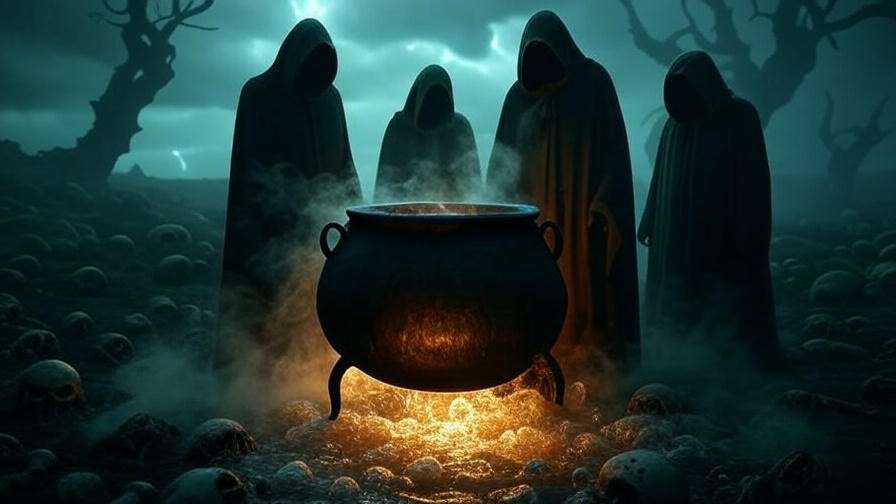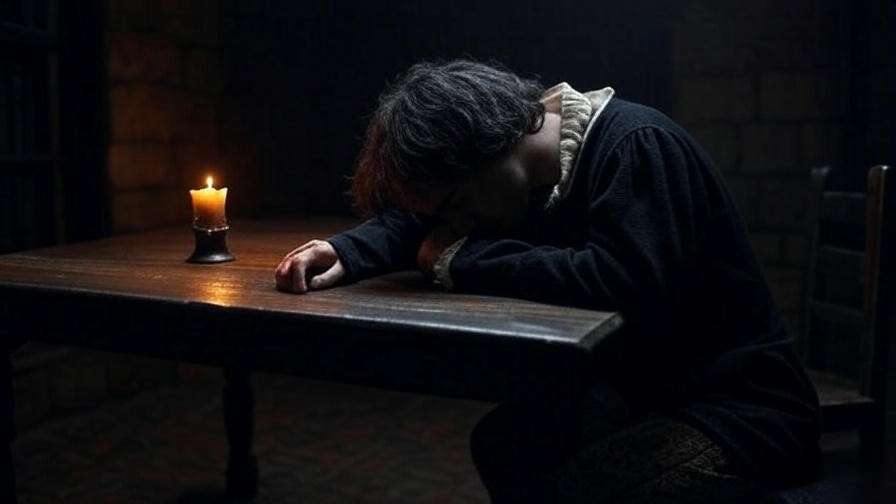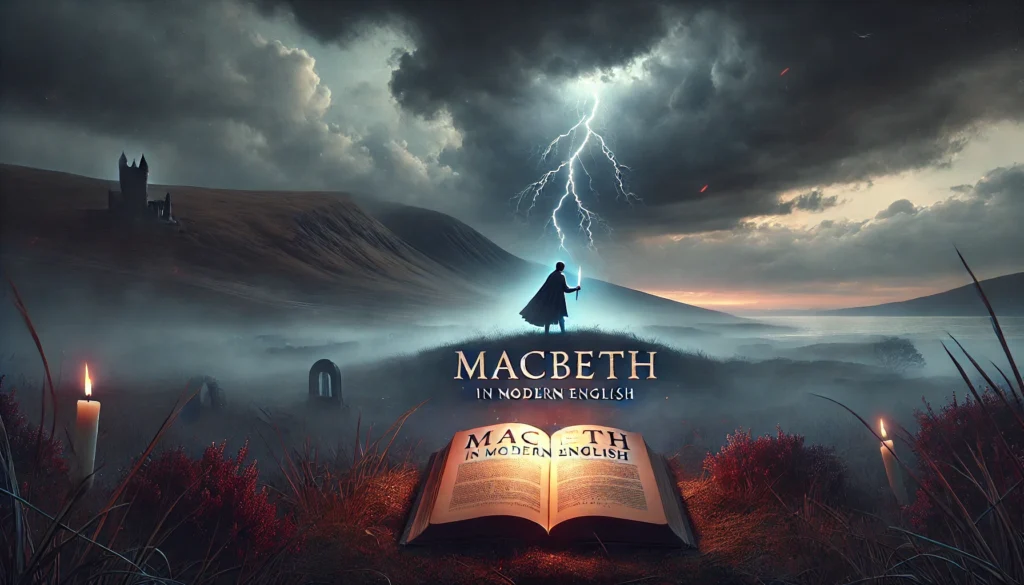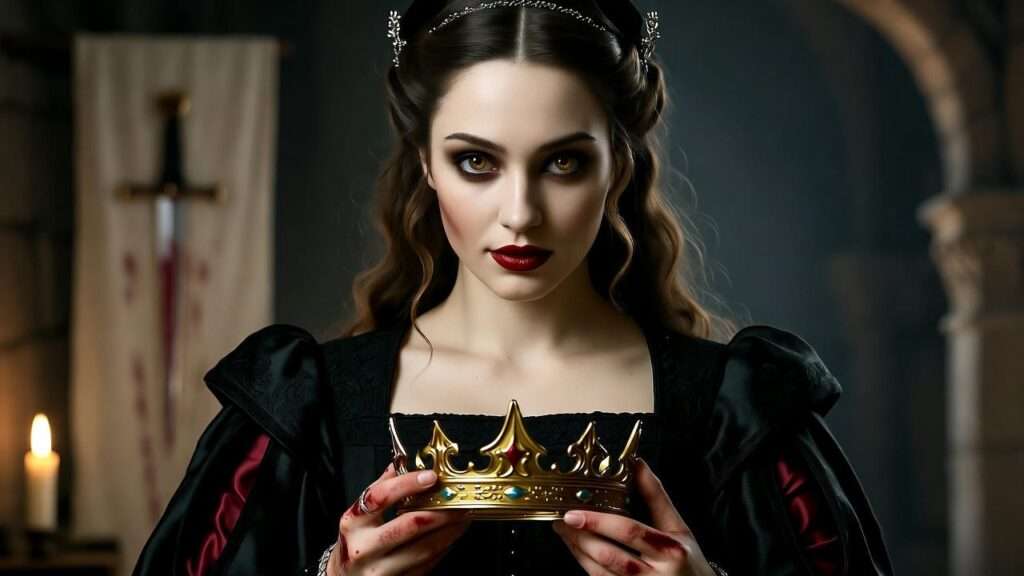Picture a stage drenched in shadow, a blood-stained hand trembling under flickering torchlight, and a dagger hovering in the air, taunting its wielder with forbidden ambition. William Shakespeare’s Macbeth is a masterclass in tragedy, weaving vivid imagery that sears itself into the mind. For students, educators, and Shakespeare enthusiasts searching for pictures that symbolize Macbeth with quotations, this article unlocks the play’s haunting visual motifs—blood, darkness, daggers, witches, and sleep—paired with iconic lines to deepen your understanding. By exploring these symbols, you’ll uncover the psychological and thematic depths of Shakespeare’s darkest tale, gaining insights for essays, discussions, or simply a richer appreciation of the play. Let’s dive into the imagery that makes Macbeth timeless.
Why Symbolism Matters in Macbeth
The Role of Imagery in Shakespeare’s Storytelling
Shakespeare’s genius lies in his ability to paint complex emotions and themes through vivid imagery. In Macbeth, symbols are not mere decorations; they are the lifeblood of the narrative, conveying the psychological turmoil of characters and the moral decay of their world. As noted by scholar Caroline Spurgeon in Shakespeare’s Imagery and What It Tells Us, the play’s symbols create a sensory experience that immerses audiences in its tragic arc. For example, recurring images of blood and darkness mirror Macbeth’s descent from noble warrior to guilt-ridden tyrant, making the play accessible yet profound for readers and theatergoers alike.
Connecting Symbols to Themes
The imagery in Macbeth ties directly to its core themes: ambition, guilt, fate, and moral corruption. Blood, for instance, embodies the irreversible consequences of unchecked ambition, while darkness cloaks the characters’ sinister deeds. These symbols resonate across centuries, offering modern audiences a lens to explore human nature. Whether you’re analyzing the play for a class or marveling at a stage production, recognizing these connections enhances your grasp of Shakespeare’s intent. Tip: When reading or watching Macbeth, note how symbols intensify the emotional weight of key scenes to enrich your interpretation.
Key Pictures That Symbolize Macbeth with Quotations
Blood – The Stain of Guilt
Blood is the most pervasive symbol in Macbeth, representing guilt, violence, and the inescapable consequences of murder. After Macbeth kills King Duncan, he stares at his bloodied hands, lamenting, “Will all great Neptune’s ocean wash this blood / Clean from my hand?” (Act 2, Scene 2). This quotation captures his realization that no amount of water can erase his guilt. Blood imagery recurs throughout the play, from Lady Macbeth’s sleepwalking cries of “Out, damned spot!” (Act 5, Scene 1) to the blood-soaked battlefields, underscoring the moral and psychological toll of their actions.
In theater and film, directors amplify this symbol through vivid visuals—red lighting, stained costumes, or pools of stage blood. For instance, Roman Polanski’s 1971 Macbeth film uses stark red hues to emphasize the brutality of Duncan’s murder. Expert Insight: Spurgeon notes that blood imagery in Macbeth creates a “continuous sense of horror,” binding the play’s themes of guilt and retribution. For students, tracking blood references can fuel powerful essay arguments about Macbeth’s unraveling psyche.
Darkness – The Cloak of Evil
Darkness in Macbeth symbolizes moral corruption, secrecy, and the concealment of evil deeds. Lady Macbeth invokes it directly, calling, “Come, thick night, / And pall thee in the dunnest smoke of hell” (Act 1, Scene 5), as she steels herself for Duncan’s murder. This quotation reveals her desire to shroud her ambition in darkness, hiding it from divine judgment. The play’s frequent references to night and shadows create an oppressive atmosphere, reflecting the characters’ descent into moral chaos.
Stage productions often use dim lighting or black backdrops to evoke this sense of dread. In Justin Kurzel’s 2015 Macbeth film, misty, shadowed landscapes amplify the theme of moral blindness. Tip: Contrast moments of darkness with rare instances of light, like Banquo’s torch in Act 3, Scene 3, to explore how Shakespeare uses light to signify hope or truth. This juxtaposition can deepen your analysis of the play’s moral landscape.
The Dagger – A Vision of Ambition
The dagger that appears to Macbeth before Duncan’s murder is a chilling symbol of his ambition and mental instability. He questions, “Is this a dagger which I see before me, / The handle toward my hand?” (Act 2, Scene 1), revealing his inner conflict as he teeters on the edge of murder. This hallucinatory image, visible only to him, embodies the seductive pull of power and the psychological unraveling it triggers. The dagger’s intangibility underscores Macbeth’s descent into paranoia, blurring the line between reality and illusion.
In visual adaptations, the dagger often appears as a ghostly or shimmering prop, heightening its eerie presence. Polanski’s film, for example, uses a faint, floating dagger to mirror Macbeth’s tormented mind. Example: For visual learners, try sketching the dagger scene to capture its surreal quality, or discuss it in a classroom setting to explore Macbeth’s psyche. This symbol offers a rich entry point for analyzing ambition’s destructive power.
The Witches – Symbols of Fate and Chaos
The witches, or Weird Sisters, are potent symbols of fate, chaos, and moral ambiguity in Macbeth. Their incantation, “Double, double toil and trouble; / Fire burn, and cauldron bubble” (Act 4, Scene 1), conjures an image of supernatural disorder, with their cauldron brewing omens that drive Macbeth’s actions. As agents of fate, they blur the line between destiny and free will, their grotesque imagery—severed limbs, poisoned entrails—amplifying the play’s sense of unease.
Artists like Henry Fuseli have depicted the witches as otherworldly figures, their twisted forms reflecting their chaotic influence. Modern productions often lean into this, using eerie costumes or special effects to make them unforgettable. Expert Insight: Scholar A.C. Bradley argues that the witches symbolize “the mysterious powers that lie behind human action,” making them central to the play’s fatalistic tone. For readers, their imagery invites debate about whether Macbeth controls his fate or is doomed by prophecy.
Sleep – The Loss of Innocence
Sleep in Macbeth represents peace, innocence, and moral clarity, all of which are shattered by the protagonists’ actions. After Duncan’s murder, Macbeth laments, “Macbeth does murder sleep” (Act 2, Scene 2), a poignant quotation that captures the loss of rest and redemption. Sleep imagery recurs as both Macbeth and Lady Macbeth are tormented by sleeplessness, their guilt denying them the solace of rest. This symbol underscores the play’s theme of moral decay, as their crimes strip them of humanity.
In productions, sleep is often visualized through restless movements or dreamlike sequences. For example, the sleepwalking scene in Act 5, Scene 1, is a theatrical highlight, with Lady Macbeth’s frantic gestures conveying her inner torment. Tip: Track sleep references across the play to build a compelling essay on how guilt erodes the characters’ humanity. This symbol resonates with audiences, reflecting universal fears of losing peace.
How These Symbols Enhance Understanding of Macbeth
Psychological Depth
The symbols in Macbeth—blood, darkness, daggers, witches, and sleep—serve as windows into the characters’ tormented minds, particularly Macbeth and Lady Macbeth. Blood, for instance, externalizes Macbeth’s guilt, transforming his hands into a constant reminder of his crimes. Similarly, Lady Macbeth’s sleepwalking, marked by her desperate attempt to wash imaginary blood from her hands, reveals her psychological collapse. These images make the characters’ inner struggles tangible, allowing audiences to empathize with their descent into madness. By analyzing these symbols, readers can explore the human cost of ambition and moral compromise, a perspective that resonates in academic study and personal reflection alike.
Thematic Resonance
Each symbol in Macbeth amplifies its core themes: ambition, guilt, fate, and moral decay. The dagger, a product of Macbeth’s fevered imagination, embodies the seductive yet destructive nature of ambition, while the witches’ chaotic imagery underscores the tension between fate and free will. Darkness cloaks the characters’ moral failings, and sleep, or its absence, highlights their lost innocence. These symbols make Macbeth timeless, as they reflect universal struggles with power, conscience, and destiny. For modern readers, these images provide a framework to discuss ethical dilemmas, making the play as relevant today as it was in Shakespeare’s time.
Practical Applications
Understanding Macbeth’s symbolism equips students, educators, and enthusiasts with tools for deeper analysis. For essays, focus on one symbol, like blood, and trace its evolution across the play to argue how it shapes the theme of guilt. For example, an essay prompt might be: “How does Shakespeare use blood imagery to explore guilt in Macbeth?” In classrooms, create a chart mapping symbols to their associated themes and quotations for quick reference. Tip: Use these symbols to spark discussions or debates, such as whether the witches control Macbeth’s fate or merely catalyze his choices. This practical approach makes the play accessible and engaging for all learners.
Visualizing Macbeth in Modern Adaptations
Symbolism in Film and Theater
Directors of Macbeth leverage symbolic imagery to bring the play’s themes to life. In Roman Polanski’s 1971 film, blood is a visceral presence, with crimson splashes dominating key scenes to emphasize violence and guilt. Conversely, Justin Kurzel’s 2015 adaptation uses stark, shadowy landscapes to evoke the darkness symbol, creating a claustrophobic sense of moral decay. Lighting, props, and costumes—such as blood-stained cloaks or ghostly daggers—enhance these symbols, making them palpable for audiences. Expert Insight: Theater critic Michael Billington praises Kurzel’s film for its “visual poetry,” noting how its imagery amplifies Shakespeare’s text. These adaptations show how symbols translate across mediums, enriching the play’s impact.
Artistic Representations
Artists have long drawn inspiration from Macbeth’s vivid imagery. Henry Fuseli’s 18th-century paintings, such as The Three Witches, capture the witches’ eerie, chaotic presence with distorted figures and dark palettes. Similarly, John Singer Sargent’s depiction of Lady Macbeth emphasizes her blood-stained hands, highlighting her guilt. These artworks distill the play’s symbols into striking visuals, offering readers a new lens to appreciate Shakespeare’s imagery. Tip: Explore these paintings online through museum websites like the Tate or Met to see how artists interpret Macbeth’s symbols. Such visuals can inspire creative projects or deepen your connection to the play.
How to Use This Knowledge
For Students and Educators
For students, analyzing Macbeth’s symbols can elevate essays and class discussions. Create a chart with columns for symbols, quotations, and themes to organize your thoughts. For example, pair the quotation “Macbeth does murder sleep” with the theme of lost innocence to argue how guilt destroys the characters’ peace. Educators can use these symbols to design engaging lesson plans, such as asking students to storyboard a scene with a focus on its imagery. Example: Assign a group project to reimagine the dagger scene as a modern art installation, emphasizing its symbolic weight. These activities make Macbeth accessible and relevant.
For Theater Enthusiasts
Theatergoers can use this knowledge to appreciate Macbeth’s staging. Notice how directors use lighting to emphasize darkness or props to highlight the dagger’s surreal quality. For instance, a production might project the witches’ cauldron onto a screen to amplify their chaotic influence. Tip: Attend a local Macbeth performance or stream a filmed version, like the 2010 RSC production with Patrick Stewart, to observe how symbols are visualized. Discussing these choices with fellow enthusiasts can deepen your appreciation of the play’s artistry.
For General Readers
Casual readers can re-read Macbeth with a focus on its imagery to uncover new layers of meaning. Keep a notebook to jot down instances of blood, darkness, or sleep, noting how they shape the narrative. For easy reference, download a PDF checklist of key symbols and quotations from our William Shakespeare Insights blog. This tool can guide your reading or spark conversations with friends about the play’s themes. By engaging with these images, you’ll discover why Macbeth remains a haunting exploration of human nature.
FAQs About Symbolism in Macbeth
Why is blood such a prominent symbol in Macbeth?
Blood represents guilt, violence, and the irreversible consequences of the characters’ actions. From Macbeth’s despairing “Will all great Neptune’s ocean wash this blood / Clean from my hand?” to Lady Macbeth’s “Out, damned spot!”, blood imagery underscores their moral and psychological decline. It appears in nearly every act, making it a central motif for analyzing the play’s themes.
How do the witches contribute to the play’s symbolic imagery?
The witches symbolize fate and chaos, their grotesque imagery—cauldrons, apparitions, and severed limbs—creating an atmosphere of supernatural dread. Their chant, “Double, double toil and trouble,” evokes a world of disorder that propels Macbeth toward his doom. In productions, their eerie visuals amplify their role as catalysts of tragedy.
How can I use Macbeth’s symbols in a literary analysis?
To analyze symbols, choose one (e.g., darkness) and trace its appearances across the play. Use quotations like “Come, thick night” to support your argument about its thematic role. Structure your essay with an introduction, evidence-based analysis, and a conclusion linking the symbol to the play’s broader themes. This approach strengthens your argument and demonstrates critical thinking.
Are these symbols relevant in modern adaptations of Macbeth?
Yes, symbols like blood and darkness remain central in modern adaptations. Directors use visual techniques—red lighting for blood, shadows for darkness—to make these images resonate with contemporary audiences. Films like Kurzel’s 2015 Macbeth show how these symbols retain their power, proving Shakespeare’s timelessness.
The powerful pictures that symbolize Macbeth—blood, darkness, daggers, witches, and sleep—bring Shakespeare’s tragedy to life, illuminating its themes of ambition, guilt, and fate. Quotations like “Will all great Neptune’s ocean wash this blood / Clean from my hand?” and “Macbeth does murder sleep” anchor these symbols, offering insights into the characters’ psyches and the play’s moral landscape. Whether you’re a student crafting an essay, an educator designing a lesson, or a reader seeking deeper meaning, these images unlock Macbeth’s enduring power. Re-read the play, watch a performance, or share your favorite symbol in the comments below to join the conversation. Shakespeare’s genius awaits your discovery.













